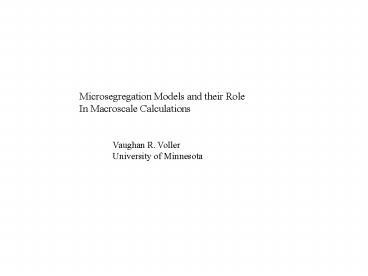Microsegregation Models and their Role - PowerPoint PPT Presentation
1 / 12
Title:
Microsegregation Models and their Role
Description:
Microsegregation Models and their Role In Macroscale Calculations Vaughan R. Voller University of Minnesota After Flemings (Solidification Processing) and Beckermann ... – PowerPoint PPT presentation
Number of Views:32
Avg rating:3.0/5.0
Title: Microsegregation Models and their Role
1
Microsegregation Models and their Role In
Macroscale Calculations
Vaughan R. Voller University of Minnesota
2
What is Macrosegregation
Partitioned solute at solid-liquid interface
After Flemings (Solidification Processing)
and Beckermann (Ency. Mat)
Cliquid
Csolid
1m
Redistributed by Fluid and solid motion
shrinkage
grain motion
convection
3
Macro (Process) Scale Equations
Equations of Motion (Flows)
mm
REV
Heat
Solute Concentrations
Assumptions for shown Eq.s -- No solid motion
--U is inter-dendritic volume flow
To advance to the next time step we need find REV
values for
- T temperature
- Cl liquid concentration
- gs solid fraction
- Cs(x) distribution of solid concentration
4
Need four relationships which can be obtained
from a micro-scale model
- Under the assumptions of
- Equilibrium at solid-liquid interface
- Perfect solute mixing in the liquid
- Identification of a solid-liquid interface length
scale - (e.g., a ½ secondary arm space)
Possible Relationships are
Definitions of mixture terms in arm space
4. Account of local scale redistribution of
solute during solidification of the arm space
1.
2.
1
Thermodynamics
3.
TG(Cl1,Cl2.)
Primary Secondary
Xs(t)
10s mm
Clk lt--gt Csk (interface)
Xl(t)t1/3
gs Xs/Xl
ClkF(Cl1,Cl2.)
coarsening
5
The Micro-Scale Model
Macro Inputs
1 mm
Xs(t)
solid
Liquid
Xl(t)t1/3
Define
Average Solute Concentration in Xl-Xsold During
time step Dt . Treat like initial sate for a new
problem
back
coarsening
macro
thermo
new solid
Iteration Guess of T in H ? Xs Xsold ?
Assume Lever on C ? Cl--, T
6
Requires a Micro-Segregation Model that to
estimate back diffusion of solute into the
solid at the solid-liquid interface
( Three Approaches)
Xs(t)
1 mm
solid
Liquid
Xl(t)t1/3
1. Numerical Solution in solid
3. At each time step approx. solid solute
profile as
2. Approximate with average parameter
Choose to satisfy Mass Balance
Function of a can be corrected for coarsening
7
Testing Binary-Eutectic Alloy. Cooling at a
constant rate
Predictions of Eutectic Fraction at end of
solidification
solid
Numerical back diff model
coarsening
Approx profile model
8
A uni-directional solidification of a Of binary
alloy cooled from a fixed chill.
Effect of Microsegregation On Macrosegregation
g
Zliq
Zeut
Microsegregation (back diffusion into solid)
modeled in terms off rate of change of solute in
liquid
z
Solute concentration in mushy region
Coarsening
lever
a ??, b 1
a 0.2
Gulliver -Scheil
No Coarsening
a0, b 0
9
Key features -- Simple Equilibrium
Thermodynamics -- External variables consistent
with macro-scale conservation statements --
Accurate approximate accounting of BD and
coarsening at each step based on current
conditions
Summary
From macro variables
1m
Find REV variables
Accounting for
solid
1 mm
1 mm
Microsegregation And Themodynamics
T ,g, Cs and Cl
at solid-liquid interface
10
I Have a BIG Computer Why DO I need an REV and a
sub grid model
solid
1 mm
mm
1m
(about 109)
Tip-interface scale
Model directly
(about 1018)
11
Well As it happened not currently Possible
1000 20.6667 Year Moores Law
2055 for tip
2010 for REV of 1mm
Voller and Porte-Agel, JCP 179, 698-703 (2002)
Plotted The three largest MacWasp Grids (number
of nodes) in each volume
12
Modeling the fluid flow requires a Two Phase
model That may need to account for Both Solid
and Liquid Velocities at low solid fractions A
switch-off of the solid velocity in a columnar
region A switch-off of velocity as solid fraction
g ? o.
An EXAMPLE 2-D form of the momentum equations in
terms of the interdentrtic fluid flow U, are
Extra Terms
turbulence
Buoyancy
Friction between solid and liquid Accounts for
mushy region morphology Requires a solid-momentum
equation

